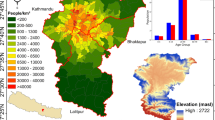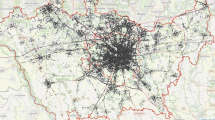Abstract
A new method for the spatially differentiated assessment of impacts of airborne pollutants on human health is presented. It is applicable to primary pollutants with linear exposure response functions. This includes the most important primary air pollutants from transportation and energy generation. The article looks at the spatial differentiation of impacts due to emission height and the local population density distribution around the emission site, as has been predicted using a Gaussian plume model. The differentiation due to population density is captured by way of five generic spatial classes: large cities in agglomerations, highly densified districts in agglomerations, cities in urbanized regions, country average districts, and low density rural districts in rural regions. Average impacts are calculated for each class. The method is simple enough to be applied to a large number of emissions within Life Cycle Assessments. It was used to calculate site-dependent exposure efficiencies for a variety of primary pollutants emitted at different heights. For traffic emissions of pollutants with short atmospheric residence times, the exposure efficiencies vary by a factor of 5 across Germany and by a factor of 75 across Europe. This differentiation due to population density decreases significantly with an increasing atmospheric residence time of the pollutants and with an increasing emission height.
Similar content being viewed by others
References
BBR (1998a): Aktuelle Daten zur Entwicklung der Städte, Kreise und Gemeinden. Berichte des BBR, Band 1. Bundesamt für Bauwesen und Raumordnung (BBR), Bonn
BBR (1998b): Personal communication. Bundesamt für Bauwesen und Raumordnung (BBR), Bonn
Christoffer J, Ulbricht-Eissing M (1989): Die bodennahen Windverhaltnisse in der Bundesrepublik Deutschland. 2., vollständig neu bearbeitete Auflage. Berichte des Deutschen Wetterdienstes Nr. 147. Deutscher Wetterdienst, Offenbach
Crettaz P (2000): From Toxic Releases to Damages on Human Health: A Method for Life Cycle Impact Assessment, with a Case Study on Domestic Rain Water Use. Dissertation, Swiss Federal Institute of Technology, Lausanne
European Commission, Directorate-General XII (1995): ExternE, Externalities of Energy, Vols. 1–5. Prepared by ETSU, UK and IER, D. Office for Official Publications of the European Communities, Luxembourg
Gerth WP, Christoffer J (1994): Windkarten von Deutschland. Meteorologische Zeitschrift, Neue Folge, 3, 67–77
Habersatter K (1990): Oekobilanz von Packstoffen Stand 1990. Schriftenreihe Umwelt Nr. 132. Bundesamt für Umwelt, Wald und Landschaft (BUWAL), Bern
Heijungs R et al. (1992): Environmental Life Cycle Assessment of Products. Guide – October 1992. Centre of Environmental Science (CML), Leiden
Heijungs R (1995): Harmonization of Methods for Impact Assessment. Environ Sci & Pollut Res 2 (4) 217–224
Hofstetter P (1998): Perspectives in Life Cycle Impact Assessment. A Structured Approach to Combine Models of the Technosphere, Ecosphere and Valuesphere. Kluwer Academic Publishers, Boston
IER (1998): EcoSense software, version 2.0. Institut für Energiewirtschaft und Rationelle Energieanwendung (IER), Universität Stuttgart
Janicke L (1998): personal communication
Jolliet O, Crettaz P (1997): Critical Surface-Time 95. A Life Cycle Impact Assessment Methodology including Fate and Exposure. Swiss Federal Institute of Technology, Lausanne
Krewitt W et al. (1998): Application of the Impact Pathway Analysis in the Context of LCA. Int J LCA 3 (2) 86–94
Manier G (1971): Untersuchungen über meteorologische Einflüsse auf die Ausbreitung von Schadgasen. Berichte des Deutschen Wetterdienstes Nr. 124. Deutscher Wetterdienst, Offenbach
Moriguchi Y, Terazono A (2000): A Simplified Model for Spatially Differentiated Impact Assessment of Air Emissions. Int J LCA 5 (5) 281–286
Nigge K-M (2000): Life Cycle Assessment of Natural Gas Vehicles. Development and Application of Site-Dependent Impact Indicators. Springer-Verlag, Berlin
Potting J, Hauschild M (1997): Predicted Environmental Impact and Expected Occurrence of Actual Environmental Impact. Part II: Spatial Differentiation in Life-Cycle Assessment via the Site-Dependent Characterisation of Environmental Impact from Emissions. Int J LCA 2 (4) 209–216
Potting J (2000): Spatial Differentiation in Life Cycle Impact Assessment. A Framework, and Site-Dependent Factors to Assess Acidification and Human Exposure. Dissertation, University of Utrecht (ISBN 90–393–2326–7)
Seinfeld JH, Pandis SN (1998): Atmospheric Chemistry and Physics. From Air Pollution to Climate Change. John Wiley & Sons, New York
Spadaro JV, Rabl A (1999): Estimates of Real Damage from Air Pollution: Site Dependence and Simple Impact Indices for LCA. Int J LCA 4 (4) 229–243
Troen I, Petersen EL (1989): European Wind Atlas. Risø National Laboratory, Roskilde, Denmark
Udo de Haes HA et al. (1999): Best Available Practice Regarding Impact Categories and Category Indicators in Life Cycle Impact Assessment. Background Document for the Second Working Group on Life Cycle Impact Assessment of SETAC-Europe (WIA-2). Int J LCA 4 (2) 66–73 and 4 (sn3) 168-174
VDI, Verein Deutscher Ingenieure (1985): Guideline 3782, Part 3, Dispersion of Air Pollutants in the Atmosphere – Determination of Plume Rise. VDI-Verlag, Düsseldorf
VDI, Verein Deutscher Ingenieure (1992): Guideline 3782, Part 1, Dispersion of Pollutants in the Atmosphere – Gaussian Dispersion Model for Air Quality Management. Beuth Verlag, Berlin
Zenger A (1998): Atmosphärische Ausbreitungsmodellierung. Grundlagen und Praxis. Springer-Verlag, Berlin
Author information
Authors and Affiliations
Corresponding author
Rights and permissions
About this article
Cite this article
Nigge, KM. Generic spatial classes for human health impacts, Part I:. Int J LCA 6, 257–264 (2001). https://doi.org/10.1007/BF02978786
Received:
Accepted:
Issue Date:
DOI: https://doi.org/10.1007/BF02978786




